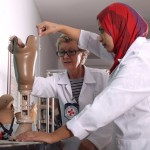Lana Kronz, 25, is a specialist in artificial limbs – artificial female lower limbs, to be precise. She works at the only orthotic and prosthetic service provider in the Gaza Strip, where 3,000 patients benefit from its services every year. ICRC has been supporting the Artificial Limbs and Polio Center (ALPC) since 2007. As part of this support, Lana was among five artificial limb and polio specialists trained in India by ICRC to bring their experience and knowledge to their colleagues in Gaza’s ALPC. Lana is the only female lower-limbs specialist in the Gaza Strip. In this interview Lana tells her story.
Lana, tell us more about yourself
My name is Lana Hassan Kronz. I have a BA in physiotherapy from Al Azhar University in Gaza. I graduated in 2010. In 2012, I received a specialized diploma in lower limbs prosthesis through an 18-month study trip sponsored by ICRC in Mobility India. I am now a specialist in lower limb prosthetics and I’ve been working for a year now in the Artificial Limbs and Polio Center (ALPC) in the Gaza Strip.
How do you spend your day in the center?
Every day when I come to the center I plan for what I’m going to do. I plan for the casting and modification of the artificial limbs, talking to the patients to make sure everything goes well with these limbs after the fitting. I spend my day not only in the workshop, but also with the patients in the clinic where I make casts for them and test the fit of the prostheses. I also spend time in the physiotherapy department where I modify and adjust the devices according to the needs of the patient.
Who are your patients?
Every person is a special case. Many of the people who come here have psychological issues because of what they went through that caused the amputation or the problem in the first instance. The least we can do is that we give support to them, smile to them; make them feel comfortable and at home so the process can go easily. We are here to support them. The pain is all gone now and time has come for them to overcome and start walking to lead their lives.
How did you become a trainee in India?

“Together with six other male colleagues we all had an exam. I was supposed to get a score higher than 60 to be able to join this program. But I got the highest mark among the applicants! “
The center was looking for people to be trained in prosthetics and orthotics in India sponsored by ICRC, especially a woman because of the sensitivity of the female cases, as you know in our society, especially when it comes to cases with amputations above the knee. Together with six other male colleagues we all had an exam. I was supposed to get a score higher than 60 to be able to join this program. But I got the highest mark among the applicants! This is how I was selected to join my colleagues in Mobility India back in 2011.
How was India?
My experience in India was very important to me. I had the opportunity to build my capabilities and study new developments in my field. It was an excellent experience which helped a lot in my work. As you know, a physiotherapist and a prosthetic technician are two very different professions, but they complement each other. Being a physiotherapist does not mean that you can do the casting and modification of the prosthesis, which exactly what I learnt. When I finished my study in India, I was unsure how I would use this new experience. But when I came back, things went very easily at work.
So, let’s talk with one of your patients, Ouda Ayash:
Hello, I am 62 years old and one of the people that Lana works with. I have an amputation in my left leg as a result of diabetes. Lana did the casting and production of my artificial leg. She helped me learn how to use it and she adjusted it correctly for me. Then she referred me to physiotherapy for gait training.
This is a great accomplishment not only for me, but also for Lana and the physiotherapists who are with her in the center. I thank them all for all what they’ve done for me. Now I’m practicing using the prosthesis on the ground, the stairs, sand, how to stand …I am in the final stage of the training with the physiotherapist. I hope to be walking independently with my new leg after finishing the training!

